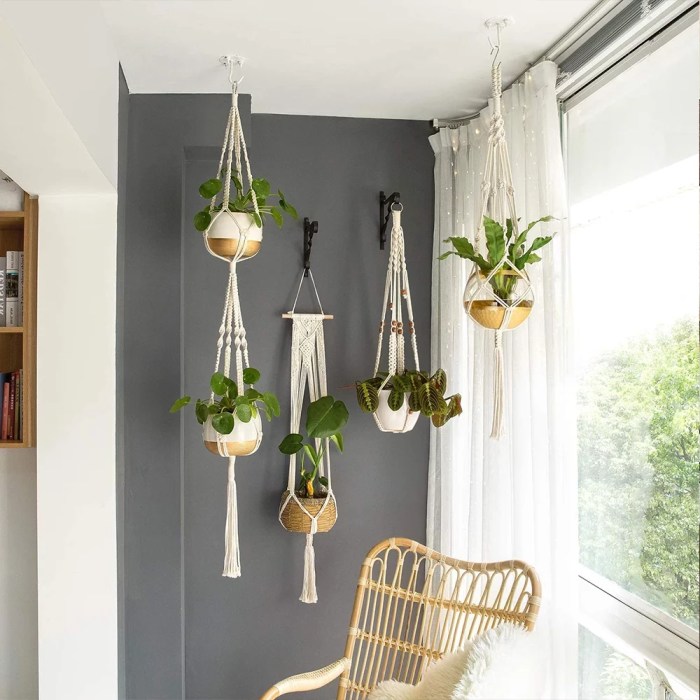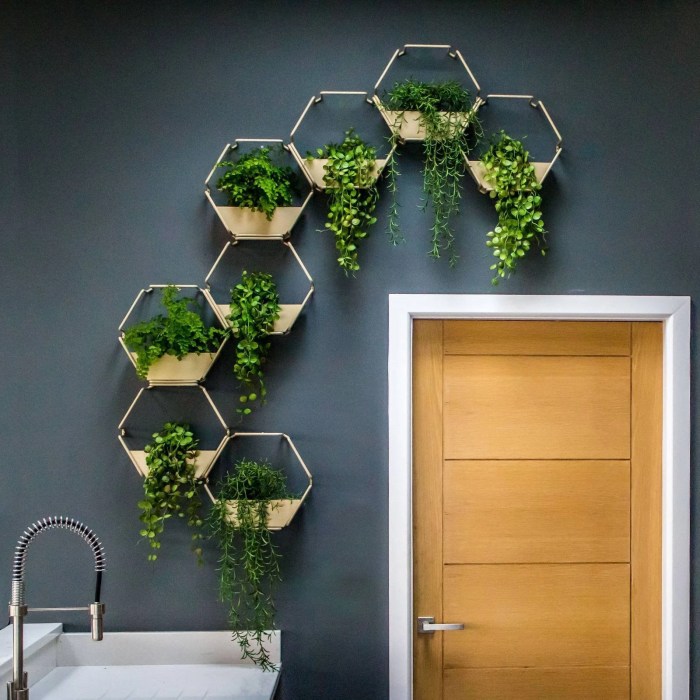Indoor hanging gardens, a symphony of nature’s artistry, bring the allure of the outdoors into the confines of your abode. These suspended havens, adorned with vibrant flora, not only elevate your living space but also offer a myriad of benefits, creating a harmonious sanctuary for both body and mind.
From cascading ferns to trailing vines, the possibilities for indoor hanging gardens are endless, inviting you to unleash your creativity and cultivate a unique botanical masterpiece.
Indoor Hanging Garden Basics

Indoor hanging gardens are a creative and space-saving way to bring greenery into your home. They are suspended from the ceiling or walls, and can be used to grow a variety of plants, from herbs and vegetables to flowers and succulents.
Hanging gardens offer several benefits, including:
- Space saving:Hanging gardens are a great way to add plants to your home without taking up valuable floor space.
- Improved air quality:Plants help to purify the air by removing toxins and releasing oxygen.
- Increased humidity:Hanging gardens can help to increase humidity levels in your home, which can be beneficial for people with respiratory problems.
- Aesthetic appeal:Hanging gardens can add a touch of beauty and elegance to your home.
There are many different types of hanging gardens, including:
- Macrame hangers:These hangers are made from knotted cords and can be used to hang plants from the ceiling or walls.
- Wire baskets:Wire baskets are a versatile option that can be used to hang plants from the ceiling, walls, or even from a shelf.
- Hanging planters:Hanging planters are typically made from ceramic or plastic and are designed to be hung from the ceiling or walls.
- DIY hangers:You can also make your own hanging gardens using materials such as wood, rope, or PVC pipe.
When creating an indoor hanging garden, there are a few factors to consider:
- The type of plants you want to grow:Some plants are better suited to hanging gardens than others. Consider the size, shape, and growth habit of the plants you want to grow.
- The amount of sunlight your home receives:If you don’t have a lot of natural light, you will need to choose plants that can tolerate low light conditions.
- The size of your space:Hanging gardens can be small or large, so be sure to choose a size that will fit your space.
- The weight of the garden:Make sure the ceiling or walls you are hanging the garden from can support the weight of the plants and the soil.
Plant Selection and Care

Selecting the right plants is crucial for a thriving indoor hanging garden. Consider factors like light availability, watering needs, and plant size.
Plant Selection, Indoor hanging garden
- Light Requirements:Choose plants that suit the light conditions in your space. Low-light plants like ferns and pothos can thrive in indirect light, while high-light plants like succulents and cacti need direct sunlight.
- Watering Needs:Determine how often your plants need watering based on their species and the humidity of your environment. Some plants, like spider plants, can tolerate infrequent watering, while others, like ferns, require more frequent watering.
- Plant Size:Consider the size of your hanging planter and the space you have available. Trailing plants like ivy and philodendrons can cascade over the sides of the planter, while upright plants like snake plants and ZZ plants add height and structure.
Indoor hanging gardens are a beautiful and practical way to add greenery to your home. They can be used to create a focal point in a room, or to add a touch of nature to a small space. One of the best ways to create an indoor hanging garden is to use trailing house plants . These plants have long, cascading stems that can be draped over the edge of a pot or basket.
They are perfect for adding a touch of drama to an indoor hanging garden.
Plant Care
Once your plants are selected, proper care is essential for their health and longevity.
- Light:Provide the appropriate amount of light based on the plants’ needs. Rotate plants regularly to ensure even light distribution.
- Water:Water your plants when the soil is dry to the touch. Avoid overwatering, as this can lead to root rot.
- Fertilizer:Fertilize your plants monthly during the growing season with a balanced fertilizer.
- Pruning:Prune your plants regularly to remove dead or damaged leaves and encourage new growth.
Suitable Plant Examples
| Plant | Light | Water | Fertilizer |
|---|---|---|---|
| Pothos | Low-moderate | Infrequent | Monthly |
| Snake Plant | Moderate-high | Infrequent | Monthly |
| Spider Plant | Low-moderate | Infrequent | Monthly |
| Fern | Low-moderate | Frequent | Monthly |
| Succulent | High | Infrequent | Monthly |
Design and Structure

Creating an aesthetically pleasing indoor hanging garden requires careful planning and attention to design principles. Consider the following elements to achieve a visually appealing and functional space:
Balance and Proportion:Arrange plants of varying sizes, shapes, and textures to create a sense of balance and visual interest. Avoid overcrowding or placing heavy plants at the top, which can disrupt the harmony of the design.
Indoor hanging gardens have gained immense popularity, offering a unique way to incorporate greenery into living spaces. Among the various hanging planters available, the triflora hanging planter stands out for its elegant design and versatility. Its three-tiered structure allows for a stunning display of plants, creating a lush and vibrant atmosphere in any room.
With indoor hanging gardens continuing to captivate homeowners, the triflora hanging planter remains a top choice for those seeking a stylish and functional way to elevate their indoor decor.
Shape and Form
Experiment with different shapes and forms to add depth and dimension to your hanging garden. Use cascading plants like pothos or spider plants to create a waterfall effect, while trailing plants such as ivy or string of pearls can add a touch of elegance and movement.
Consider using hanging baskets, macrame hangers, or trellises to support and display plants in unique ways.
Materials
The materials you choose for your hanging garden can significantly impact its overall aesthetic. Natural materials like wicker, jute, and bamboo bring a touch of warmth and organic beauty, while metal hangers and macrame provide a more modern and industrial look.
Consider the weight and durability of the materials to ensure they can adequately support your plants.
Lighting and Maintenance: Indoor Hanging Garden
Proper lighting is crucial for the health and well-being of indoor hanging gardens. Natural light is always the best option, but it’s not always feasible in indoor environments. Therefore, artificial lighting becomes essential to provide the necessary light for plant growth and development.
There are various types of artificial lighting options available, each with its own advantages and disadvantages. The type of lighting chosen should depend on the specific plants being grown and their light requirements.
Light Requirements for Plants
- Low-light plants:These plants can tolerate low light conditions and do not require a lot of light to thrive. Examples include snake plants, ZZ plants, and pothos.
- Medium-light plants:These plants require more light than low-light plants but can still tolerate some shade. Examples include peace lilies, spider plants, and ferns.
- High-light plants:These plants need bright, direct light to grow well. Examples include succulents, cacti, and citrus trees.
Maintenance Checklist
Regular maintenance is essential to keep indoor hanging gardens healthy and thriving. This includes:
- Watering:The frequency of watering will vary depending on the type of plants, the size of the pots, and the humidity levels in the room. Generally, it’s best to water when the top inch or two of soil feels dry to the touch.
- Fertilizing:Plants need nutrients to grow and thrive. Fertilize indoor hanging gardens every few weeks during the growing season using a balanced liquid fertilizer.
- Pruning:Pruning helps to remove dead or damaged leaves, encourage new growth, and maintain the desired shape of the plants.
Inspiration and Examples
Indoor hanging gardens are captivating spaces that bring a touch of nature indoors, creating a serene and revitalizing atmosphere. From elaborate botanical displays to practical space-saving solutions, these gardens showcase the boundless possibilities of vertical gardening.
Showcase of Inspiring Indoor Hanging Gardens
Around the world, indoor hanging gardens have been embraced for their aesthetic appeal and functional benefits. Here’s a gallery showcasing some of the most inspiring examples:
-
-*Green Oasis in Singapore
The Gardens by the Bay boasts the Cloud Forest, an indoor conservatory with a 35-meter-high waterfall and lush vegetation suspended from the ceiling, creating a breathtaking jungle-like experience.
-*Vertical Living Wall in New York City
The High Line, an elevated park built on a former railway, features a vertical living wall with over 500 species of plants, transforming the urban landscape into a vibrant green tapestry.
-*Urban Sanctuary in London
The Barbican Conservatory is an indoor jungle hidden within a brutalist architectural complex, offering a tranquil retreat with exotic plants and a cascading waterfall.
-*Space-Saving Solution in Tokyo
In the space-constrained metropolis of Tokyo, hanging gardens are a popular way to add greenery to small apartments. They can be used to create vertical herb gardens, indoor plant displays, or even miniature Zen gardens.
These examples demonstrate the creative and practical applications of indoor hanging gardens, inspiring us to incorporate this innovative gardening concept into our own spaces.
Final Summary
Indoor hanging gardens, with their aesthetic charm and therapeutic benefits, have emerged as a captivating trend in modern interior design. Whether you seek to add a touch of greenery to your living room, create a tranquil retreat in your bedroom, or enhance the ambiance of your office, an indoor hanging garden offers endless possibilities to transform your space into a verdant sanctuary.
General Inquiries
What are the benefits of having an indoor hanging garden?
Indoor hanging gardens offer a plethora of benefits, including improved air quality, reduced stress levels, increased humidity, and a touch of natural beauty to your living space.
How do I choose the right plants for my indoor hanging garden?
Consider factors such as the amount of light your space receives, the humidity level, and the size of your hanging planter. Choose plants that are well-suited to these conditions and that complement your desired aesthetic.
How often should I water my indoor hanging plants?
The frequency of watering depends on the type of plants you choose, the humidity level in your home, and the size of your hanging planter. As a general rule, water your plants when the soil feels dry to the touch.